Menus
- BMW K 1300 S versus Honda VFR 1200 F
- Driving behavior
- Touring suitability
- Technical data Honda VFR 1200 F
- Technical data BMW K 1300 S
- Brake measurements
- Conclusion
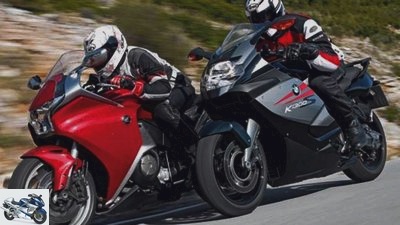
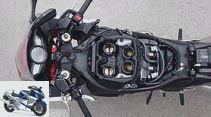
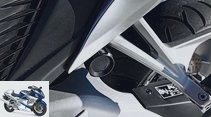

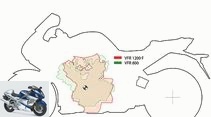
12th photos
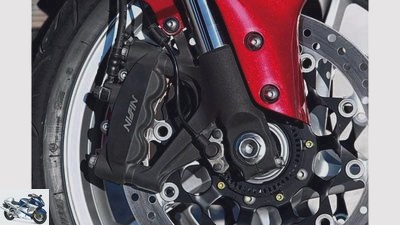
1/12
Top brakes: radially screwed six-piston stoppers, ABS and integral actuation.
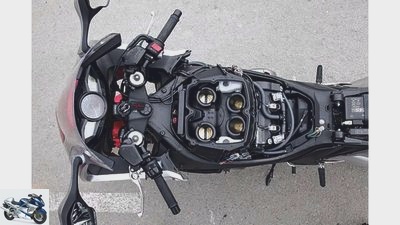
2/12
Builds compact and very narrow: the two rear cylinders sit between the two front ones.
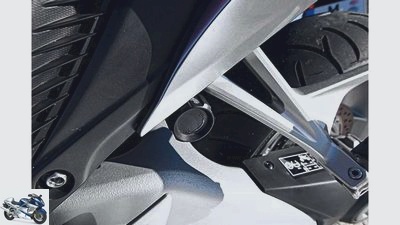
3/12
The preload of the lever-operated shock absorber can be adjusted to the load in no time using a practical handwheel.
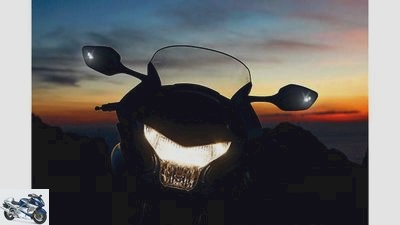
4/12
Safe: LEDs in the mirrors increase visibility.
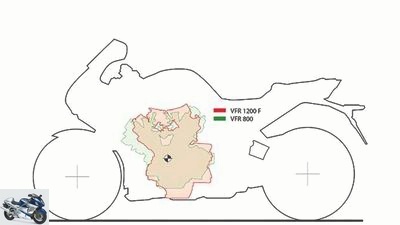
Drawing: archive
5/12
Tight 76 degree cylinder angles make the 1200 shorter and higher than the 90 ° -V4 of the 800.
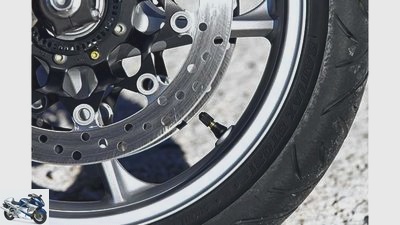
6/12
Checking the tire pressure at the front is difficult, depending on the tester, because of the large brake discs and the non-cranked valve.
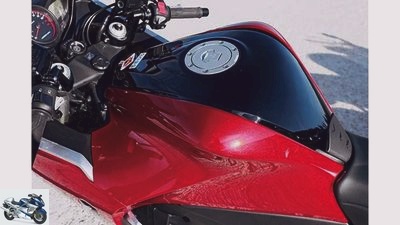
7/12
Humpback whale: The 18.5 liter steel tank (black) is flanked by red plastic panels.
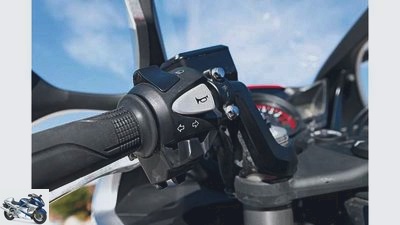
8/12
Horn and turn signal switches have swapped their usual positions, so the driver, who has been conditioned for years, first honks his horn when turning.
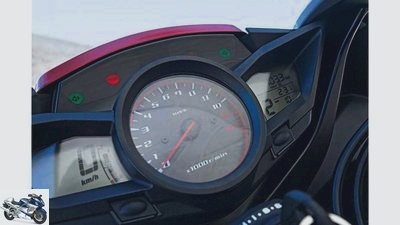
9/12
Infotainment: dominant rev counter and gear indicator, but no consumption indicator.
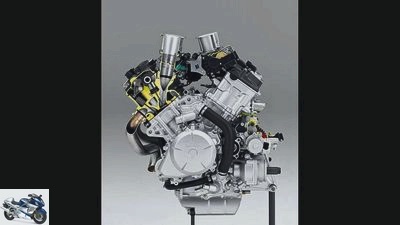
Drawing: fact
10/12
Head work: The cylinder banks each carry an overhead camshaft with roller rocker arms and bucket tappets.
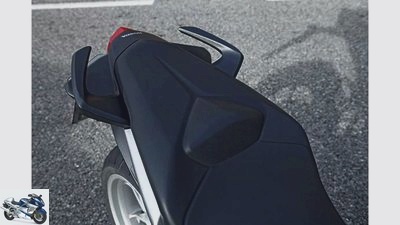
11/12
Passable place: The triangular pillion seat is tightly padded and is rather narrow for wide rear parts.
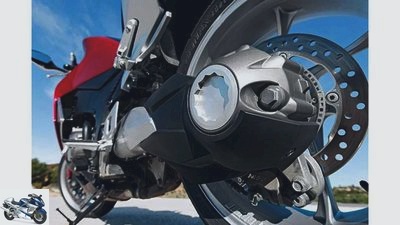
12/12
One sign: the first cardan on a VFR. Easy to care for and cleverly designed even without torque support. The continuous swing axis above the cardan tunnel brings stability, a constant velocity joint ensures length compensation.
Comparison test sports tourer, BMW K 1300 S, Honda VFR 1200 F
BMW K 1300 S versus Honda VFR 1200 F
Honda opens the exchange of blows with the new VFR, which is aimed fully at the center of the BMW clientele. The modern interpretation of a sports tourer with a wide range of uses. How much sport and how much touring are in the VFR 1200 F and K 1300 S.?
The entire afternoon the handlebars restlessly and restlessly swings around its middle position without ever remaining there for more than two or three seconds. One curve follows the other, sometimes sharp and tricky, sometimes wide and fast. A pre-Christmas fairy tale? No, a heavenly earthly tour in the middle of winter in the picturesque mountain landscape near the Côte d‘Azur. In which the two machines are the icing on the cake. You scurry playfully through the tangle of curves, a whopping 170 hp at the top push forward with such fervor that the front wheel only gently taps the asphalt. Wonderful, it actually has nothing to do with work, it’s pure pleasure.
Buy complete article
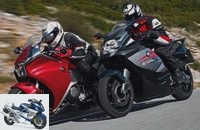
Comparison test sports tourer
BMW K 1300 S versus Honda VFR 1200 F
VFR 1200 F and BMW K 1300 S. Machines with which you can cover a longer journey for two without feeling every single bone in the evening. Classic sports tourers. A term that manufacturers obviously fear like the devil feared holy water. Honda leaves the VFR 1200 F under the nebulous term "Road sport" run, BMW throws the K 1300 S together with the S 1000 R in the pot of the athletes. What actually makes the term sports tourer a no-go? Sure, some of the younger representatives of this species weren’t a hit. But one shouldn’t hold the entire industry accountable for the unfortunate fate of individuals.
Sports tourers are, in principle, true all-rounders. They are hot enough for the home route – see above – but are also suitable for the weekend tour with a pillion passenger and luggage. And big bikes like the VFR 1200 F and K 1300 S are the current peak of this guild. Also and especially in terms of power: the nominally 173 hp VFR is aimed precisely at the 175 hp K 1300 S. The concept is similar – a powerful four-cylinder drives the rear wheel via a cardan drive in both of them – but the implementation is quite different. BMW is taking an unconventional approach to chassis technology with Duolever front suspension, while Honda is more likely to do so with the engine with an unusually nested 76-degree V4, the compact Unicam heads of which are derived from the in-house crossers. It will be interesting to see how the different philosophies affect practice and who gets more points in the end. The battle of the giants goes into the first round.
The VFR has a clear cockpit but with a rather sparse information policy. Instead, the braking system with huge six-piston pliers is without blame.
But before the first meter is even driven, BMW has already secured a solid point lead. The test machine shows off extensive equipment. Extras, which, however, have to be bought with sometimes hefty surcharges. With almost 18,000 euros, customers spend almost 3,000 euros more on a luxuriously equipped BMW than for a VFR with basic equipment. Electronically controlled chassis, anti-slip regulation, tire pressure control, automatic gearshift: Honda cannot offer all of this as an option.
Unnecessary frills? Not at all. Even such mundane things as the fairly accurate remaining range display on the BMW on-board computer can be quickly learned to appreciate when the petrol station network is sparse. One would also like this display on the Honda, which, with its 18-liter tank, forces you to refuel earlier when consumption is higher (on the country road 5.9 liters compared to 5.3 liters for the 19-liter bunkering BMW). A little more tank volume would be good for both of them, however, with committed movement the range quickly shrinks to less than 250 kilometers.
The VFR does not conduct any experiments in chassis technology. And that doesn’t have to be a disadvantage, there is absolutely nothing wrong with conventional, proven technology. Especially when it is implemented as convincingly as with the VFR. With a very comfortable set-up, the Honda VFR ironed out breaks and messing about in the asphalt more elegantly than the BMW, which reacts a little stiffly to hard edges. Cardan reactions are even less noticeable than with the BMW, although the simple VFR drive train does not have a torque support.
The BMW with its automatic gearshift for lightning-fast upshifts under full load. Also with electronic suspension adjustment ESA with display in the cockpit.
Even in the comfort setting of the ESA, the chassis of the S looks firmer, sportier and can be changed quickly and effectively with a few push of a button on the handlebars while driving. For example, when suddenly the oats bite you. To do this, the Honda driver has to stop and use the screwdriver. However, he will quickly find that even with the rebound stage completely closed on the rear shock absorber, there is little damping reserves left for two-person operation.
In contrast to the ESA chassis, the BMW driver hardly ever uses another electronic feature in everyday life: the ASC anti-slip control. In contrast to the traction controls performed by athletes, this is not about driving at the limit, but about increased safety in an emergency. The electronics do not override the limits of physics, but if you give the K too much spurs on dubious terrain, the ASC intervenes.
This can happen with a measured 174 hp, as the 1300 K engines simply go to the point in a bestial manner and push forward fervently in every speed range with incredible vehemence. Power that is also present acoustically. The BMW in-line four snaps you with a hearty one when you start it up "woof" at. And when the exhaust flap clears the way, the K throws its power into the ether. Sound and feeling that some people don’t expect from BMW. The driver not only hears the engine, he also feels it. Especially in the middle area when the handlebars and seat are tingling. Nevertheless, the K-Kraftwerk never becomes insidious and, thanks to the linear power development, is always easy to control with the throttle. In plain language: Little gas means little propulsion, a lot of gas means a lot of pressure – a lot.
Driving behavior
Weird birds: Both hide their not inconsiderable mass well, but the Honda demands more concentration.
Which is a little different with the Honda. At the top, the VFR develops a comparable boost, a few horsepower or not play a role in everyday life. The fact that it remains eight hp below the factory specification is therefore insignificant, especially since it locks on the highway at 250 km / h anyway. The one-off, irregular, throbbing blow of the V4 engine when the exhaust flap opens at around 6000 rpm is potentially addictive. But only as long as you demand the engine, in the lower regions of its repertoire, the VFR lacks the appropriate pressure, which unfortunately also applies to the sound. The fact that a fat 1200 falls into such a hole when accelerating at 3000 revs is a bit disappointing, especially in relation to the Bavarian power man. With the parallel passage, the Honda driver has to shift down a gear in order to keep up with the BMW.
Where there are valleys, the mountains always beckon. After the turbo diesel hole has been overcome, the thrust of the VFR sets in all the more violently. It certainly turns out to be how the force seems to increase within a few hundred revolutions, how the VFR suddenly advances. A special kick, which is not entirely uncritical. In the top test course, the VFR decorated the asphalt with long black lines. It would be nice if it weren’t for the less amusing flip side of the coin, the impending highsider danger that is not averted by any electronic helpers.
The handling, on the other hand, is absolutely convincing, on both machines. They are certainly not as easy to drive as the lively 600s, but little of the 258 or 268 kilograms can be felt while driving. Both machines can be thrown from one lean angle into the other on winding roads without using excessive force. In curves, the BMW runs extremely neutrally and precisely thanks to the Conti tires that harmonize perfectly with the K chassis. Unfortunately, Honda put the test machine on the Bridgestone BT 021 instead of the much better harmonizing Dunlop Roadsmart, which develop a life of its own in corners and require constant correction.
The picturesque mountain landscape in the south of France is perfected with a ride on the two sports tourers.
In contrast to the engine and chassis, where BMW clearly dominates, there is a stalemate when it comes to braking. Both have ABS and a partially integrated composite brake. The box above explains the different philosophies. It should be noted that this is about braking in the ABS control range, the BMW is clearly better at coping with such extreme experiences. The Honda brake can boast slight advantages in day-to-day practice. The powerful six-piston pliers provide the better pressure point and clearer feedback, fading is a foreign concept for this system. With the BMW, the pressure point on the lever moves a little when you blow down a pass. And sensitive drivers miss some feedback and sensitivity. But it doesn’t matter, because the deceleration values of the elongated K models are known to be brutal.
At the end of a day on the motorcycle, ergonomic differences are significant. The BMW is surprisingly narrow, despite its wider four-in-line car, and the knee joint on the tank is perfect for both large and small drivers. The K driver sits higher and closer to the handlebars, so a bit sportier. The high notches also fit into this picture, the price for unlimited freedom of inclination is a more acute knee angle. Perhaps not as comfortable in the long run as on the VFR, where the rider sits in rather than on the motorcycle, but also has to stretch a little more for the handlebars. Overall, the VFR is the more comfortable motorcycle, the K the sportier one.
Which could almost be the bottom line of the story. 1-0 for BMW: It is the victory of an excellent motorcycle over a very good one, one could draw on the conclusion of the top test of the VFR in MOTRRRAD 1/2010. And it is a clear, undisputed victory, the K 1300 S is ahead of the VFR 1200 F in almost every discipline. It is amazing what manners the people of Munich have now instilled in the K model. With the VFR, the less harmonious power delivery is particularly surprising, the stubborn driving behavior could easily be improved with other tires.
Touring suitability
The VFR is sporty, but what touring qualities are in the Honda? The reference here is the K 1300 GT.
Sport or touring? There is no question about that with a K 1300 GT. The GT is a powerful, heavy motorcycle, both in terms of dimensions and mass. But it’s always surprising how handy and easy the GT can be to drive on winding roads. Nevertheless, in direct comparison, the VFR plays in a different league with good balance and easier handling. After all, there are almost 270 kilograms (VFR) compared to a whopping 300 kilograms (K 1300 GT). The same applies to the engine as said in the comparison test, the even slightly better pulling K clearly outperforms the VFR with its impressive torque and linear power characteristics.
But what about the Honda’s tourist capabilities? The GT is certainly the more comfortable motorcycle. Driver and passenger enjoy seating in the “First Class” category, even if the front seat cushion could be upholstered a little tighter. With the Honda you have to differentiate: the driver is accommodated in the “Business Class”, high comfort even on long journeys. His pillion, on the other hand, has to be satisfied with a seat from the Holzklasse brand: a bit hard and cramped.
Luxury also characterizes the on-board equipment of the GT: the full equipment includes an excellent, electrically adjustable draft shield. The much smaller, but aerodynamically sophisticated fairing of the VFR offers less wind protection, but also less turbulence.
Conclusion: As a tourer, the GT is almost unbeatable on long journeys. It is not for nothing that it is the undisputed number one on the MOTORRAD best list with 768 points.
Technical data Honda VFR 1200 F
The huge silencer of the Honda is striking. The elaborate technology of the V4 engine with Unicam cylinder heads and nested cylinders, on the other hand, remains hidden.
Engine:
Water-cooled four-cylinder, four-stroke 76-degree V-engine, one overhead, chain-driven camshaft, four valves per cylinder, fork rocker arms and bucket tappets, wet sump lubrication, injection, Ø 44 mm, regulated catalytic converter, 570 W alternator, 12 V / 12 Ah battery , hydraulically operated multi-plate oil bath clutch, (anti-hopping), six-speed gearbox, cardan shaft, secondary gear ratio 2,699.
Bore x stroke 81.0 x 60.0 mm
Cubic capacity 1237 cm³
Compression ratio 12: 1
rated capacity 127.0 kW (173 hp) at 10,000 rpm
Max. Torque 129 Nm at 8750 rpm
Landing gear:
Bridge frame made of aluminum, upside-down fork, Ø 43 mm, adjustable spring base and rebound damping, single-sided swing arm made of aluminum, central spring strut with lever system, adjustable spring base and rebound damping, double disc brake at the front, Ø 320 mm, six-piston fixed caliper, disc brake at the rear, Ø 276 mm, Double-piston floating caliper, partially integral brake system with ABS.
Cast aluminum wheels 3.50 x 17; 6.00 x 17
Tires 120/70 ZR 17; 190/55 ZR 17
Tires in the test Bridgestone BT 021 “N”
Mass and weight:
Wheelbase 1545 mm, steering head angle 64.5 degrees, caster 101 mm, spring travel f / r 120/130 mm, seat height * 800 mm, weight with a full tank * 268 kg, payload * 195 kg, tank capacity 18.5 liters.
guarantee three years
Service intervals 12,000 km
Colours Red, silver, white
price 14,900 euros
Additional costs around 170 euros
* MOTORCYCLE measurements
Technical data BMW K 1300 S
BMW puts a lot of effort into the chassis and drive. Suspension and damping can be adjusted electronically from the handlebar. The cardan drive works with torque support and optimized jerk damping in order to minimize reactions.
Engine:
Water-cooled four-cylinder four-stroke in-line engine, two balance shafts, two overhead, gear / chain-driven camshafts, four valves per cylinder, rocker arm, dry sump lubrication, injection, Ø 46 mm, regulated catalytic converter, alternator 580 W, battery 12 V / 14 Ah, hydraulically operated Multi-disc oil bath clutch, six-speed gearbox, cardan shaft, secondary ratio 2.82.
Bore x stroke 80.0 x 64.3 mm
Cubic capacity 1293 cm³
Compression ratio 13: 1
rated capacity 129.0 kW (175 hp) at 9250 rpm
Max. Torque 140 Nm at 8250 rpm
Landing gear:
Bridge frame made of aluminum, double longitudinal control arm made of aluminum (with ESA: adjustable damping), steering damper, two-joint single-sided swing arm made of aluminum, central spring strut with lever system, adjustable spring base and rebound damping (with ESA: adjustable spring base, rebound and compression damping), double disc brake at the front, Ø 320 mm , Four-piston fixed calipers, rear disc brake, Ø 265 mm, double-piston floating caliper, partially integral brake system with ABS.
Cast aluminum wheels 3.50 x 17; 6.00 x 17
Tires 120/70 ZR 17; 190/55 ZR 17
Tires in the test Continental Sport Attack, rear “C”
Mass and weight:
Wheelbase 1585 mm, steering head angle 60.4 degrees, caster 104 mm, spring travel f / r 115/135 mm, seat height * 830 mm, weight with a full tank * 258 kg, payload * 202 kg, tank capacity / reserve 19.0 / 4.0 liters.
Guarantee two years
Mobility guarantee two years
Service intervals 10000 km
Colours Gray-black / orange / silver metallic
price 15950 euros
Price test motorcycle ** 17,900 euros
Additional costs around 206 euros
* MOTORCYCLE measurement
** including: Safety package (400 euros): RDC, ASC, ESA electronically adjustable chassis (740 euros), shift assistant (360 euros), heated grips (195 euros), on-board computer (145 euros), luggage rack (110 euros).




12th photos
Pictures: Comparison test sports tourer
To home page
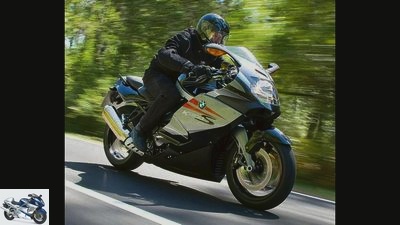
BMW
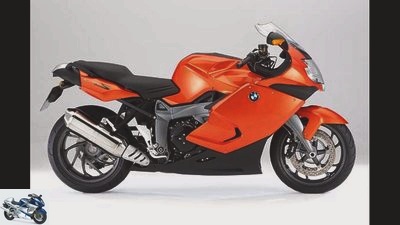
BMW
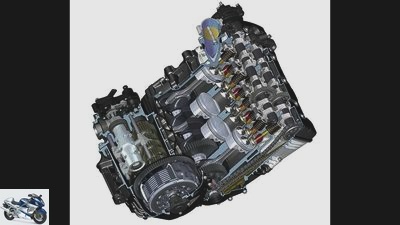
BMW
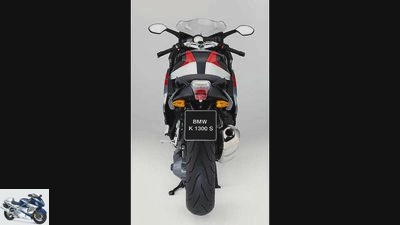
BMW

BMW
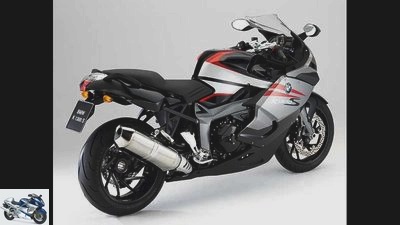
BMW
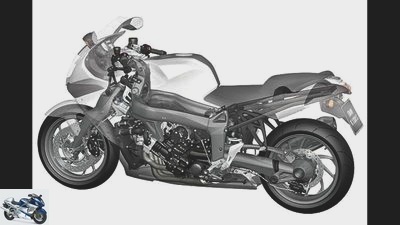
BMW
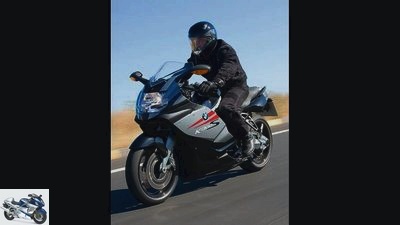
BMW
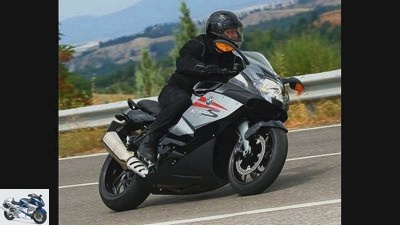
BMW
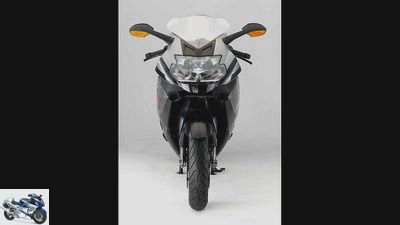
BMW
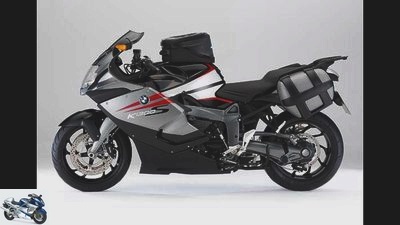
BMW
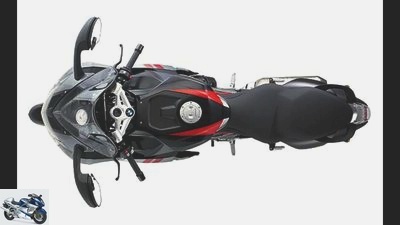
BMW
Measurements
Drawing: archive
Power on the crankshaft. Measurements on Dynojet roller test stand 250, corrected according to 95/1 / EG, maximum possible deviation ± 5%.
At 3000 rpm the VFR falls into a hole, only to then increase even more. The increase in performance at 6500 rpm, only indicated in the diagram, has a much greater effect in the lower gears. The slight waves of the BMW, however, are not noticeable, the K 1300 S has endless pressure everywhere.
Top speed
| Manufacturer | km / h |
| BMW | 285 |
| Honda | 250 |
acceleration
| Manufacturer | 0-100 km / h (in seconds) |
0-140 km / h (in seconds) | 0-200 km / h (in seconds) |
| BMW | 2.9 | 4.3 | 7.8 |
| Honda | 3.0 | 4.7 | 8.9 |
Draft
| Manufacturer | 60-100 km / h (in seconds) | 100-140 km / h (in seconds) | 140-180 km / h (in seconds) |
| BMW | 3.3 | 3.2 | 3.4 |
| Honda | 4.5 | 3.8 | 4.1 |
Fuel consumption (country road)
| Manufacturer | Liters / 100 km |
| BMW | 5.3 |
| Honda | 5.9 |
Theoretical range (country road)
| Manufacturer | kilometre |
| BMW | 358 |
| Honda | 314 |
Brake measurements
Both rely on ABS, but BMW and Honda are going different ways when it comes to the function and effect of the composite brake.
Let’s talk about an emergency: the driver pulls hard on the lever and the ABS has to prevent the wheels from locking. Of course, fine control behavior and short braking distances are what count. The decisive factor for the two test machines is which lever you pull or press. With the BMW, the rear brake is automatically activated when the hand lever is pulled, but the pedal only works at the rear. At Honda, the pedal acts on both brakes, while the lever only acts on the front.
So two different philosophies of a partially integral composite effect. The BMW is more suitable for experienced motorcyclists who, for example, want to brake in isolation when entering corners. The Honda is easier to brake for less experienced drivers who put more pressure on the pedal in an emergency. It always decelerates quite well, whether you operate a lever, pedal or both.
Surprisingly, however, that the front brake only results in mediocre braking distances in the ABS control range. The tip for VFR drivers must therefore be to use both brakes in an emergency. The K 1300 easily achieves a brutal ten m / s2. And it doesn’t really matter whether you just use the hand lever or use the pedal to help. Braking only at the rear is of little use. So an advantage for BMW? In principle yes. However, the K regulates and pulsates rather coarse, the ABS of the VFR does the job extremely sensitively – although not quite as effectively.
Braking from 100 km / h
| BMW K 1300 S. |
delay | Braking distance |
| Both brakes |
10.2 m / s² | 37.8 m |
| Front brake only |
10.2 m / s² | 37.8 m |
| Rear brake only |
4.4 m / s² | 89.7 m |
| Honda VFR 1200 F. |
delay | Braking distance |
| Both brakes |
9.5 m / s² | 40.6 m |
| Front brake only |
8.2 m / s² | 47.0 m |
| Rear brake only |
8.1 m / s² | 47.6 m |
Conclusion
Both bikes are not quite as close as here in the picture.
1st place: BMW K 1300 S
There is no herb against the Bayern-Express with its inspiring, powerful drive, great chassis and complete equipment.
2nd place: Honda VFR 1200 F
Without question, it is also a good motorcycle, but because of the surprising lack of torque and the unfortunate tires on the test machine, it has no chance.
Drawing: archive
Rating engine
The performance of the BMW is inviolable, the four in a row simply pushes ahead powerfully. The V4 of the Honda is certainly not bad, but when it pulls through it suffers a slack and cuts the top speed at 250 km / h. On the other hand, the VFR scores with the entire drive train, the clutch and transmission work more smoothly, and the load changes are more gentle. The K makes the gear change harder, and the clutch grabs a little.
Winner engine: BMW
Drawing: archive
Scoring chassis
What difference do tires make: With Dunlop Roadsmart the VFR ran quite smoothly at the presentations, with Bridgestone BT 021 it reacts stubbornly to bumps and has to be brought into an inclined position with more force. This is less noticeable on flat, fast passages. It is astonishing how well BMW has the previously somewhat awkward Duolever chassis under control. With the Conti Sport Attack, the K 1300 S drives very balanced and neutral.
Chassis winner: BMW
Drawing: archive
Evaluation of everyday life
The different ergonomics are ultimately more a matter of taste. Honda offers the more comfortable, BMW the sportier seat. The VFR is a shade ahead when it comes to wind protection and visibility in the mirrors. The K 1300 counters this with extensive standard and extra equipment and in handling, such nice things as accessible tire valves or simple oil control count.
Winner everyday life: BMW
Drawing: archive
Security rating
In this chapter, the VFR can finally counter: It has excellent brakes with steady pressure point and clear feedback. However, the BMW slows down brutally in the ABS control area. Hitting the handlebars is not an issue at all with the VFR, and with the K 1300 it is only just beginning to be noticed.
Safety winner: BMW
Drawing: archive
Valuation costs
Three year guarantee for the VFR, that should be a role model and incentive for the competitors. Despite a slightly higher consumption, the Honda wins this chapter.
Winner costs: BMW
| Maximum | BMW | Honda | |
| Overall rating | 1000 | 742 | 693 |
| placement | 1. | 2. | |
| Price-performance note | Top grade 1.0 |
2.2 |
2.3
Price-performance winner: BMW
With the many extras, the K 1300 S is quite expensive, but also offers more for the money than the basic version of the Honda.
Related articles
-
Comparison test: Honda VFR 800 against VFR 1200 F
fact 25 pictures fact 1/25 old against new: Honda VFR 800 (in the foreground) against the new VFR 1200 F. fact 2/25 Honda VFR 1200 F (right) against the …
-
Comparison test of the 1000 super sports car in 2006
fact Comparison test of the 1000 super sports car in 2006 The show must go on The mystery repeats itself. Whenever we think that nothing is going up, the…
-
Comparison test of the 1000 super sports car
Jaime de Diego 38 photos fact 1/38 Yamaha charges 14,895 euros for their completely new R1 super sports bike. fact 2/38 Even without ABS, the Fireblade…
-
Comparison test Honda VFR 800 F, Kawasaki Z 1000 SX and BMW R 1200 RS
fact 32 pictures fact 1/32 The Honda VFR 800 F looks small and compact, but carries a lot of weight with it: 245 kg with a full tank. fact 2/32 The …
-
Comparison test BMW K 1300 S, Honda VFR 1200 F DCT and Yamaha FJR 1300 AS
Arturo Rivas 30th photos Rivas 1/30 Comparison test: Tourer with shifting aids – BMW K 1300 S, Honda VFR 1200 F DCT and Yamaha FJR 1300 AS. Rivas 2/30…
-
Comparison test BMW K 1200 RS against Ducati 944 ST2 against Honda VFR
Comparison test BMW K 1200 RS against Ducati 944 ST2 against Honda VFR Three just in case Three motorcycles, three different concepts, one requirement:…
-
factstudio.de 29 photos fact 1/29 One against all. Ducati SuperSport S in comparison test with Suzuki GSX-S 1000 F, Kawasaki Z 1000 SX, Honda VFR 800 F…
-
Sports tourer concepts in a comparison test
www.factstudio.de 29 photos www.factstudio.de 1/29 Experience German-German history: The heavily secured border with wall and barriers between East and…
-
50,000 km endurance test Honda Crosstourer
Bilski 35 photos fact 1/35 The V-shaped headlight says what’s going on: Here comes one V4 machine brushed up. Your high touring screen costs extra. fact…
-
fact 12th photos fact 1/12 Top brakes: radially screwed six-piston stoppers, ABS and integral actuation. fact 2/12 Builds compact and very narrow: the…